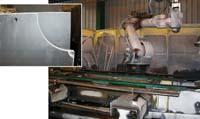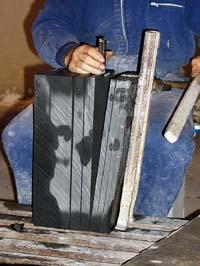Stone that becomes a table

In the book Sobre la pizarra, Xabier Mendiguren Elizegi tells us the quarries of Itsasondo. The Sarasola family owned the largest slate farm in Itsasondo, and one of the brothers bought the land of the Olea hamlet in the Arriaran district of Beasain to remove the slate there. But the owners of the Olea hamlet, the Mendizabal, did not sell them all the land. Following the lessons of others, they opened the quarry in the 1950s. Subsequently, the slate farms of Itsasondo sank, but that of Mendizabal de Arriaran continues to work in the XXI. Also in the 20th century.
This quarry began to work when the paper notebooks were a luxury, and the schoolchildren benefited from what had been taken off the mountain. The blackboard was then used to make blackboards and electrical panels.
Underground surface
At that time, the slate mine was buried. With force and shovel, they acted underground like moles. First we had to open the gallery like a formon. For the opening of this formidable trench a dynamite was used that breathed several gases and dust. The work was hard, really. Today, the galleries that cross the mountain witness their underground work. Underground exploitation lasted between 20 and 25 years. Subsequently, the quarry was removed on the ground. In about a year production doubled. Not having to use trenches or dynamites, the works were quite simplified, according to the head of the quarry of Arriaran, Juan Mendizabal.
Arriaran is similar to other slate quarries. Saws are used to cut the rock that is divided into layers. This is the main characteristic of slate, its separation power in sheets or layers. Giant tools with small widia plates hang from the wall and cut the stone into blocks 3 meters thick and 12 meters long. It is a job of between six and seven hours. Once the stone is knocked down it is cut into smaller pieces. The cut parts are taken to the factory. The blackboard is worked there. This worked slate extends all over the world, but turned into a pool table. Almost 80% of Arriaran quarry production is used for this purpose.

Billiard tables
About 30 years ago they began to build pool tables with the stones of Arriaran. For the manufacture of the pool tables, the stone is first cut on the loom, in plates of different thickness. Then the thicknesses requested by the customer of these plates are cut with the saw.
The next step is to polish these sheets. Once polished, the edges are chamfered to the slate plate. A robot finishes its work in 10 minutes. It also makes holes for the introduction of screws used for falling balls and clamping the slate structure.
More than 80% of pool tables are located in restaurants, hotels, etc. That is, children, youth or adults use it for play or leisure. It is usually called American billiards. Usually this type of pool has a piece of slate 2 centimeters thick.
In professional billiards (candy, etc.) a 5 centimeter slate is needed. And those are the thickest. In addition, according to Juan Mendizabal, experts give you the feeling that the slate is 5, 3 or 2 centimeters. According to them, the ball runs better in a layer of slate of 5 centimeters, more accurately.

At the best tables, the ball gives as many pots as centimeters thick have the stone. To do this, experts drop the ball from a height of one foot, about 30 centimeters. In the absence of surprises, at the slate tables of Goierri, the balls emit a boat per centimeter.
Why not in construction?
When they began to build the pool tables in Arriaran, all the production was sent to the United States. Today, however, they are outside this market and receive their applications mainly from Central America (Mexico and Puerto Rico) and Europe (Spain, France and England). The competition comes from China, Brazil and Italy.
Perhaps that is why, instead of limiting Arriaran's production to pool tables, they want to make a small leap to the construction sector. But they know that the grayish black colour characteristic of the Arriaran slate deteriorates when placed outside the facades. That is, they know that the slate would erode and lose color. Natural greyish would lose color and the coloration would be whitish. Most marbles have something similar.
Therefore, the Cidemco technology center is working on the study of the Arriaran slate and on the definition of how it should be treated for use in construction (facades and floors). For this purpose, several tests have been carried out in which it has been possible to verify that the aforementioned color change is mainly due to rain and solar rays.

Therefore, your next challenge is to define which products that slate needs in order not to lose color both with the rain and with the rays of the sun. To do this, they introduce the sample into a machine and submit it to ultraviolet rays, simulating somehow the sun, extrapolating the data obtained from this test and recognizing the behavior of the slate on the outside.
These studies have been launched recently and will still have to conduct numerous trials to see what the actual results say. Meanwhile, the Arriaran workshop will continue to form pool tables.






